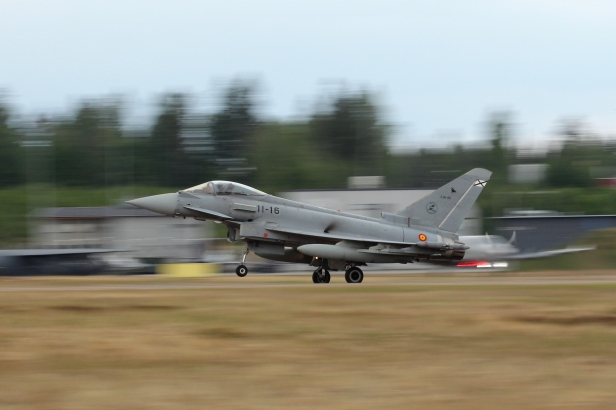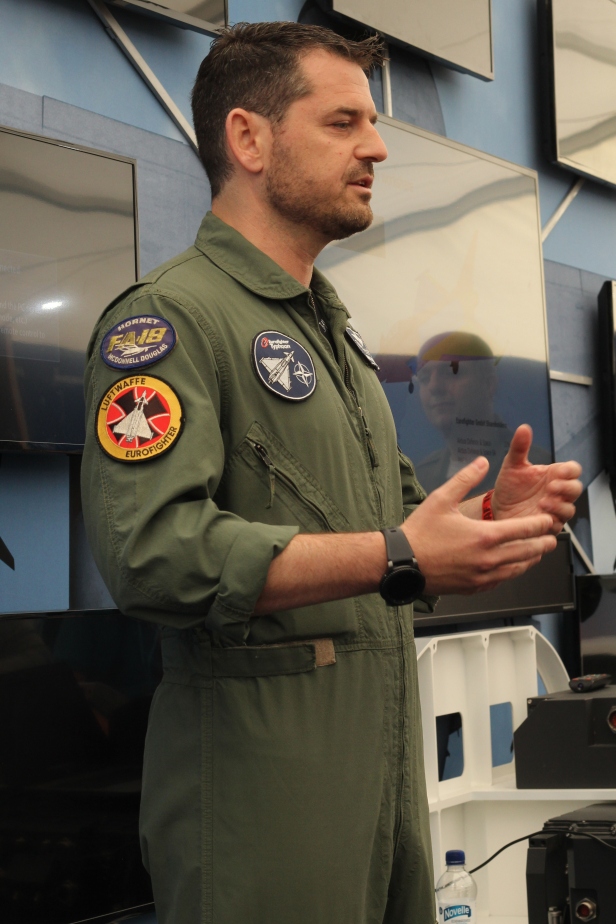So BAE Systems had a problem. They had managed to create some buzz in Finnish media by bringing the Eurofighter Typhoon to the Finnish capital last summer and taking part in a major airshow there. However, the fact that BAE Systems is the lead of the HX-marketing program was starting to give the picture of the aircraft as being a British fighter. And with the whole Brexit-mess ongoing, the idea of investing in closer ties with Britain might not sound tempting to the Finnish public. Something had to be done to bring the “Euro” in the “Eurofighter” firmly into view of the Finnish public.
Enter the main Finnish air show of 2018. Lockheed-Martin brought a mock-up, Saab two JAS 39C (one flying and one static) and a 39E mock-up, Dassault three Rafale (two flying and a spare), and Boeing brought two EA-18G Growlers (one flying and one static).
Eurofighter brought six Typhoons, with five aircraft (representing all four partner nations) on static display, and one for the RAF flying display. In addition both BAE Systems and Airbus had their own stands next to each other, with one of the two Spanish Eurofighters parked in front of them.

Raffael Klaschka, former Luftwaffe Typhoon-pilot and current head of marketing for Eurofighter GmbH, flew in from his office in Munich to attend the air show. And the message is clear: The Eurofighter is a core air defence system for Europe, with almost 500 aircraft responsible for the air defence of half the population of the European Union, and it is set to remain that way past 2050. That includes the time after the Future Air Combat System is rolled out, as the Eurofighter representatives are keen to point out that the FCAS is much more than just a new stealth fighter, being a complete concept which will include an important role for the Typhoon as well (a similar point was raised by Dassault with regards to the future of the Rafale).

Another issue which was heavily emphasized in the discussions in Tikkakoski was that a Finnish Eurofighter-buy would effectively land Finland many of the benefits enjoyed by the original four partner nations. This includes full access to all aircraft systems and subsystems, as well as representation amongst the partners at the Munich headquarters. “There’s no closed black boxes for European partners,” BAE Systems test pilot Paul Smith notes, a clear reference to a number of transatlantic systems where sealed black boxes have to be shipped back to the manufacturer for maintenance. For the HX-programme where security of supply and an indigenous industrial base able to support the aircraft in peace and war has been one of the main themes, this is exactly the message the Finnish Defence Logistics Command wants to hear.
And the good news doesn’t end there. “Finland will get the E-scan, the very latest version of the E-scan,” Paul assures the gathered crowd of journalists. He refers to the AESA-radar which is currently being flight tested on the Typhoon. Next to him he has a full-scale cutaway model of the nose, with the PIRATE IRST-sensor and the E-scan, together with a number of black boxes representative of the units driving the sensors. “Size does matter” is another of the lines pushed by the company, as the Typhoon has ample room for growth both when it comes to power output for subsystems as well as the physical size of the sensors.

However, while the fighter is a decidedly European in build and concept, the Typhoon is fully interoperable with US fighters. This goes beyond just sporting a NATO-standard Link 16, but the Typhoon has shown to be a plug-and-play asset in stateside Red Flag-exercises where several of the partner nations have ‘fought’ both with and against the best US assets, including both F-22 Raptor and F-35 Lightning. While some of the more spectacular accounts are disputed, it is clear that the Typhoon has emerged as a both flexible and highly valued multirole fighter to BLUFOR, and one that indeed is able to be seamlessly integrated into any NATO-led coalition out there.


I’m Spaniard living in Finland so perhaps I can help with the “Spanish experience”. The Eurofighter is good and having the Spanish air force a 2 fighter policy (do not put all the eggs in the same basket) they are happy, but at what price. Spain joined the Eurofighter for political reasons, we already had the F-18, the best multi-role fighter in Europe in the beginning of the 90s but had to join the euro Frankenstein. Would have been better and far cheaper purchase the Super Hornet, at least for us. The Typhoon is good but over rated. The Super Hornet buys more “bang for the buck”. Besides that, the US is the best friend and ally anyone can have, the rest of your “European allies” would sell you for a dime.